I woke up about 6am - there was no sight or sound from anyone so I stayed in bed reading. I finally came out about 8 and JB and Tina were having breakfast. Today was the day the pig was being killed. The family had bought a pig and the butcher would kill it at his place then deliver it here and cut it up. JB had done butchering between being a carpenter and becoming a mailman. Tina's family had butchered a pig the last time he was here about 2 years ago. Now they were doing it again.
Someone arrived and picked up Tina's father and JB - it wasn't long before they returned with a dead pig in tow.
The butcher skinned the pig; the pig was cut in half and each half hung by a hook from the metal posts of the grapevine.
Then there was a pause for some Rakia - Macedonia's national drink made from grapes. Then the butchering began in earnest. A 6+ inch slice of a tree trunk was placed on the outdoor table - then a piece of a large cardboard box was place on top of that. The butcher would carve a big chunk of meat then place it on the large piece of cardboard. He used a large knife to cut it up into pieces. There were numerous tin pans where the meat was placed. The wasps had been pesky from the sweetness of the grapes but now they were out in full force! The butcher and the pig were covered with them. The little puppy was delighted with the odd piece/bone he could grab - some bones were bigger than he was.
JB trimmed fat from some of the cuts of meat and helped bring the pans into the house. Then the butcher and Tina's father spray washed everything including the table - Violeta came out and washed the table. Then it was time for a congratulatory jigger of Rakia and a beer.
The celebration did not last long. The butcher left for his next appointment; Tina's parents got to work sorting the meat that was going into the freezer; Violeta started cooking for the lunch for the relatives; and Violeta and Tina started cleaning. Violeta will not let me do anything - not even take something off the table in the kitchen. So John and I headed to Bitola to get out of everyone's way.
Bus stop on the road to Bitola from Novaci. Most bus stops are covered in graffiti and posters.
I think there is some significance to this street art but I don't remember what it was.
Since today was a beautiful sunny day, everyone thought that the cafes along Shirok Sokok would be packed. When we got into Bitola there were roadblocks along the main roads due to some kind of road race. So we went to the Bitola Institute and Museum - it was formerly one of two buildings of the former military academy - this is the White building - the Red building was destroyed in WWI. The 2nd floor is divided in two - to the left is the museum dedicated to Mustafa Kemal later called Ataturk, who helped found modern day Turkey - he was born in Thessaloniki but went to this military high school at the end of the 19th century. I told JB that I wanted to start with the right section on Bitola - if there was time, we could do Ataturk.
I was surprised at how large the local museum was - it contained many artifacts from Heraclea - most dated from the 1st to 6th centuries AD but there was even earlier pottery as well as mammoths's teeth. I loved seeing everything from Heraclea since we were just there yesterday. The displays moved from neolithic times up to the near present.
Mosaic from Heraclea
There was no explanation for this but perhaps a model of a building in Heraclea?
These are the early Christian saints who came to teach the Slavs about Christianity in their own Slavic language.
Imagine wearing these high heels! Look at how high those heels are! And below is the whole outfit.
Family room of a home in Bitola from the end of the 19th and beginning of the 20th century. I was looking for a piano - supposedly at that time every other house in Bitola had a piano.
These chairs and tapestry were in the hallway of the exhibition - I was dying to sit on one and try it out.
Displays of Macedonian traditional costumes.
I can only read the bottom line of this poster - "The Exodus of the Bitola's Jews - 11th March 1943." If anyone can read it, I would love to know what it says.
Jews had lived in Monastir (the old name for Bitola) since Roman times. There were some Jews in other areas of Macedonia, but the majority of them lived in Monastir. I have read that the Sultans had welcomed the Jews for their education and business acumen. The Sultans came to rely on Jewish business men in running the Ottoman Empire. Because Monastir was on the major trade route between Rome and Constantinople, Jews became wealthy merchants until the overthrow of the Ottoman Empire. Then because of political strife, shifting boundaries, and economic losses, thousands of Jews had emigrated by WWII.
On April 6, 1941 Nazi Germany attacked Yugoslavia - on April 9 Monastir was occupied by Nazis. For 3 days the Germans looted Jewish-owned shops across Macedonia. Also during April 1941, the Bulgarian army, allied with Nazi Germany, entered Monastir - they immediately began anti-Jewish measures including moving the Monastir Jews into a ghetto, depriving them of Bulgarian citizenship, confiscating Jewish property.
At dawn on March 11, 1942 German and Bulgarian soldiers broke into Jewish homes and told the inhabitants that they had one hour to be ready to travel to the center of the country. The Jewish quarter/ghetto of Monastir/Bitola was surrounded so no one could escape. At 7 am they were taken out of their homes which were then searched to make sure everyone was out. They were then herded into cattle cars that used to transport horses among other things and taken to Skopje - all 793 Jewish families - 3351 men, women, children - of Monastir. In Skopje they were locked up with the rest of the Jews of Macedonia in the old "Monopol" tobacco warehouses. They were then deported to the killing center of Treblinka in Poland and murdered.
This is a list of almost all the Jews in Monastir - they had to register with the Nazi and Bulgarian authorities - they were later murdered in Treblinka.
The rest of the local museum had information and artifacts from the uprisings against the Ottoman Empire, the partisans fighting against the Nazis. The museum was very impressive.
I have been interested in the 3 religions originating with Abraham - Christian, Jewish, and Muslim. So I had wanted to go to the Jewish Memorial Museum in Skopje, but missed it due to lack of time. I wanted to see the Jewish cemetery here in Bitola before and after seeing the small mention of the Monastir Jews in the local museum. So John drove me over there - it is on a hill and is now blocked by the construction of a new Aldi's going up in front of it. I had read in Bradt's guidebook that the Jewish cemetery of Bitola is one of the oldest – if not the oldest – Jewish cemetery in the Balkans - founded in 1497. "It was abandoned and left to ruin after the deportation of all Bitola’s Jews in 1943. A civic campaign to restore the cemetery and create a Holocaust memorial complex began in 1997 to coincide with the 500th anniversary of its foundation. Considerable work has been carried out, including the restoration of the monumental entrance gate, declared a national historical-cultural monument, which has a central Gothic arch flanked by two Gothic-arched windows and features a facade whose upper part is decoratively ribbed. There is a display room in the memorial house there ...
The cemetery extends up a fairly steep hill, from 600-670 meters above sea level, and extends over about 4.3 hectares. It is fully enclosed by a wall (three sides are masonry, but part of the front is decorative iron grille work.) The main gate stands at the bottom of the hill. Several thousand grave markers remain, but most are illegible. Most of the gravestones lie flat, in the Sephardic manner ... In August 2015, the mayor of Bitola and Israeli ambassador to Macedonia signed a declaration to protect and preserve the cemetery, and a project was launched to create a memorial park there."
There is an engraved inscription at the top of the gate but I can't make it out except 1497 - 1929.
This is the entrance gate - each window has a Star of David. But the walkway is uneven and trash is strewn all around.
Look at the trash!
The gate was locked so we couldn't get in - here it looked like a hole was dug and gravestones were lying on top of each other. There are more graves in the background. I couldn't walk up alongside the fence because there was no sidewalk. It certainly seemed like a mess to me. How sad to see the neglect - a whole Jewish community in Bitola murdered and forgotten.
We next drove to the hospital where there is a small memorial to the holocaust survivors - JB had to park in the emergency room parking lot while I ran over to get a quick picture of the memorial which we had passed several times.
Street art
The Bitola welcoming cup - Bitola is known for being chill and one way to do that is to have a cup of coffee in the many street cafes.
We decided to drive through the center of town on our way home - we lucked out and found a parking space right near the Clock Tower.
Sign in Braille explaining the history of the Clock Tower! My daughter worked at Perkins School for the Blind for many years so this reminded me of her.
Plaque near the Clock tower: "After WWI, two doctors from the USA, Dr Regina Flood Keyes and Dr Frances Mabel Flood, known as the Two Angels of Bitola opened the American Women's Hospital (AWH) supported by the American Red Cross to help the local population. We have managed to win the war, now we must win the peace was the motto of the American Mission.'
As we headed toward Magnolia Square, we took a detour left to St Dimitry's Church which was built in 1830 - it replaced a former chapel from 1726 that burnt down. It had to be built with special permission from the Ottoman authorities - it had to be a plain building lower than the surrounding mosques. It is the main Macedonian Orthodox Church of Bitola.
I'm trying to learn about the Orthodox Church since it derived from the Catholic Church originally and I know Popes have outreached to the Orthodox hierarchy to attempt a closer relationship.
The following are pictures from the interior - a lot more ornate than a Catholic Church - but the outside had to be plain so the inside is more lavish.

The iconostasis is carved from wood.
The slender chairs along the wall look brand new unlike the ones below.
More new chairs.
There were several lights with a Star of David on them. It seemed appropriate considering where we had just been.
As we were leaving there was someone collecting an admission fee - JB tried to pay it but the man waved it aside so JB bought a couple of candles for me. Still praying for a special intention.
Outside courtyard with a lovely marble bench to rest on.
Here is a pool in the shape of a cross to be used on the Feast of the Epiphany.
We headed home after this visit - we didn't want to be late for dinner and be rude. The company had already arrived when we got there at about 2:30. The woman was Tina's father's cousin - their fathers were 2 brothers - her brother lives next door to Tina. She and her husband live in Melbourne, Australia and were home for a visit to see their families.
Violeta served the men and herself Rakia and beer at the beginning of the meal.The table was weighted down with food as usual - 2 kinds of homemade salads, a huge platter of liver and a plate of pork bellies from this morning's pig! Violeta then brought in a platter of sautéed peppers, onions and mushrooms which JB and I both thought was outstanding! Unfortunately I still don't like liver although I gave it a try, and the pork bellies were too tough for me to chew. So I loaded up with vegetables as usual.
JB and Tina went to sit in the living room after eating. Violeta or Tina brought out baklava and those coconut balls that are Tina's favorites. The cousin had brought what looked like small eclairs without the chocolate frosting - but they had a syrup over them and nothing inside. Ilce came in to eat and then made me and Tina a coffee with ice cream while everyone else had Turkish coffee. The cousins were good company and the wife would pause frequently to let me know what they were talking about. I think they were here for almost 4 hours then Ilce drove them back to their rented apartment in Bitola.
We sat outside for a while talking then everyone went to bed early after the excitement of the pig and the cousins.
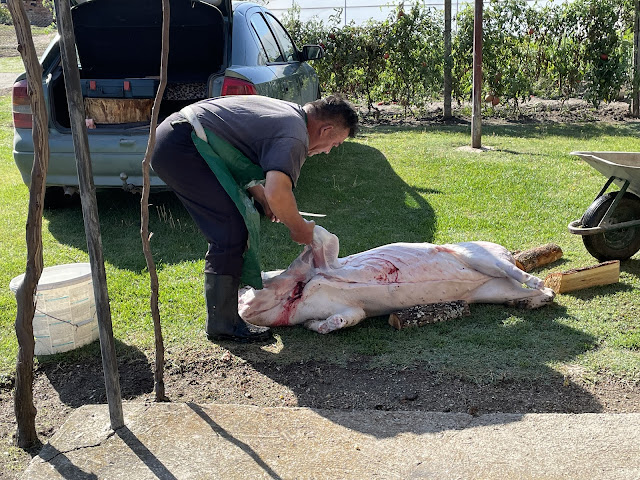

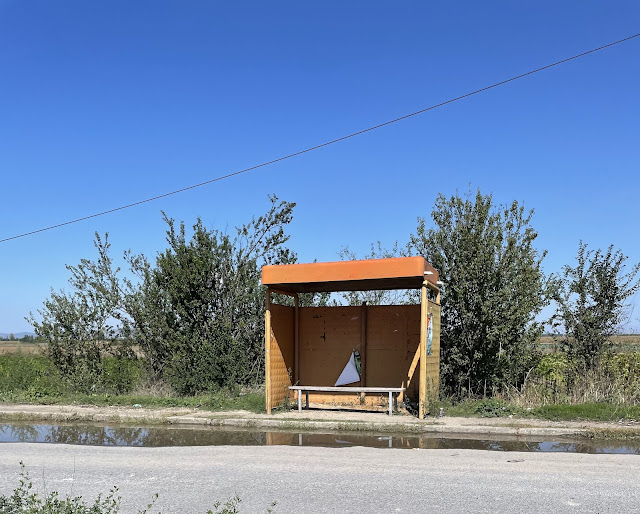
























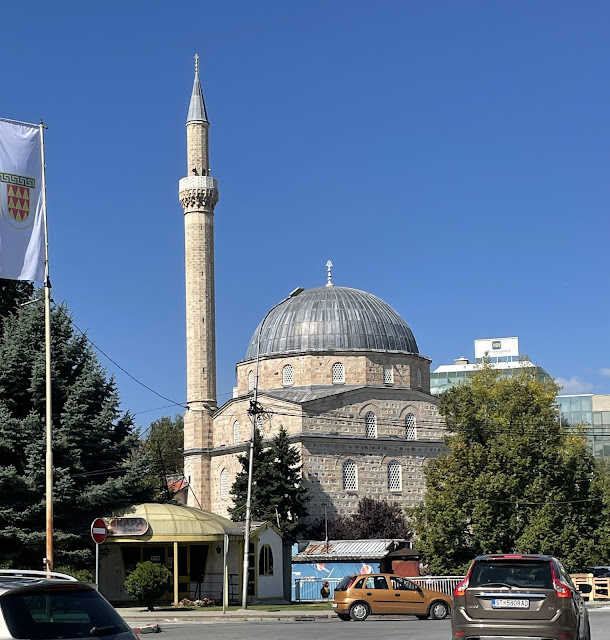


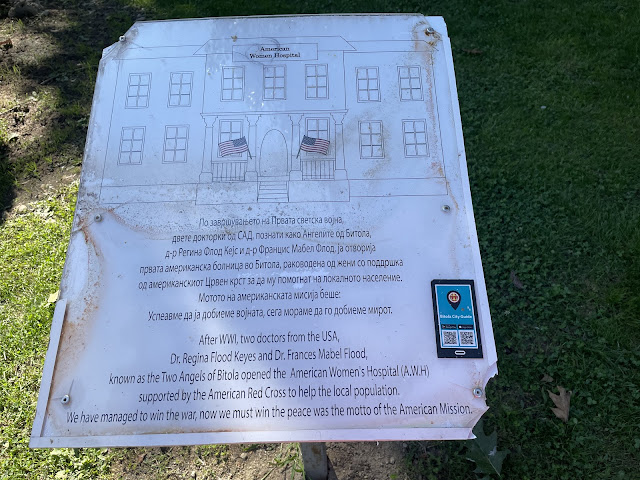





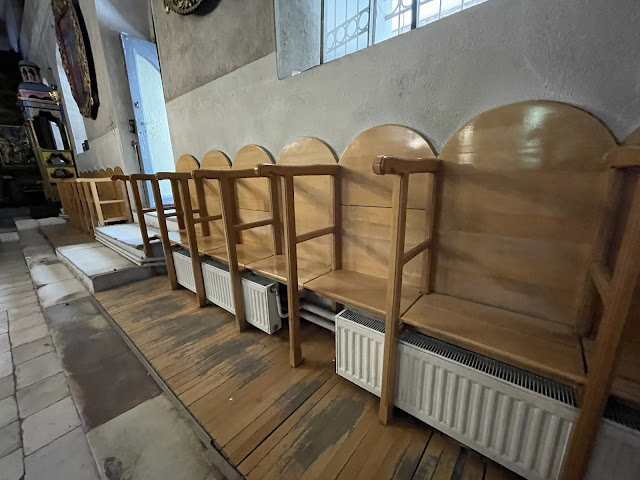









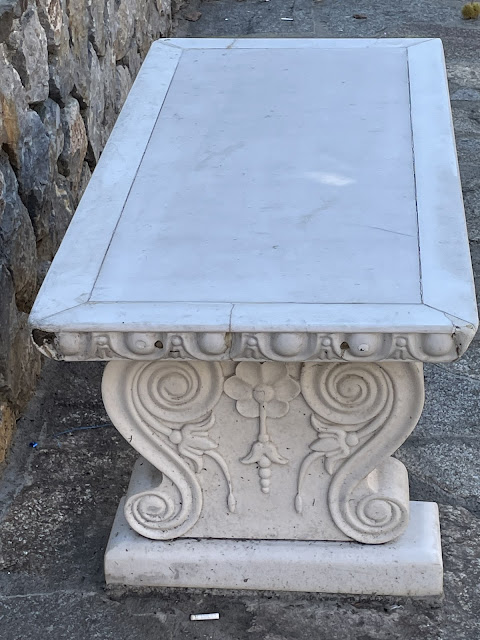


No comments:
Post a Comment